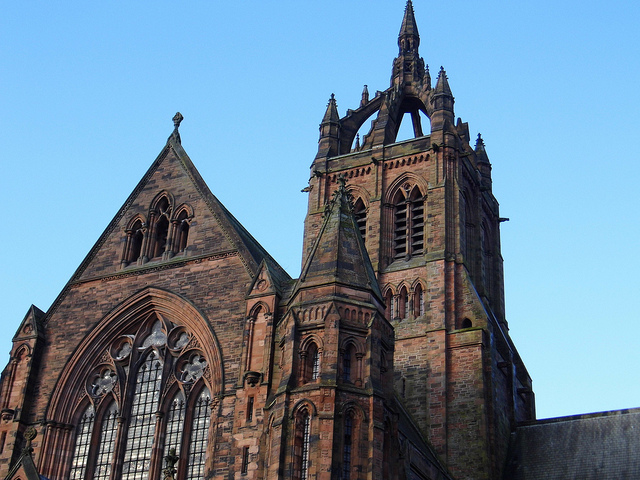Scottish Parliament Election preview: Labour’s setting sun in the West
The West of Scotland is, in common with the rest of the country, a region where Labour has lost seats at a considerable rate, with 2016 likely to continue the trend. Here, Murray Leith rounds off Democratic Audit’s Scottish Parliament election previews, suggesting that Labour’s sun is setting in the West.

Paisley Abbey (credit: Paisley Scotland)
How tables turn and situations change. Nothing stands as a better example of Labour’s decline, the SNPs rise, and the resilience of the Scottish Conservatives’ than the West Scotland region. In 1999, the region was called the West of Scotland and had nine constituencies and the usual seven list seats for a total of 16 MSPs from the area. After the first boundary review, it became known as West Scotland and grew to encompass 10 constituencies and seven lists seats, so now provides 17 of Scotland’s MSPs. In many respects, it could claim to be one of the ‘forgotten’ regions of the Scottish parliament. With central Scotland sometimes referred to as the heartlands of Labour support, and Glasgow, perhaps even the beating heart itself, what of the West? It certainly deserves not to be dismissed, because even though it has usually provided a rainbow like result on the lists, it started out as bedrock red as Glasgow and the central area.
In 1999, Labour swept the West (of) Scotland constituencies, taking all nine with an average percentage majority in the teens. This prominence left them out off the list results, where they still took over a third of the vote. The SNP took four list seats, the Conservatives two, and the Lib Dems one. It certainly seemed to represent the image of Scottish politics. However, by 2011, it represented a very different image, although perhaps just that of the new Scotland as much as the new Scottish politics.
In 2011, Labour had been reduced to being the second largest party in the region with only seven MSPs, four from constituency seats and three from the list. The SNP had become the largest party with eight MSPs, six of them directly elected and two from the lists. The Liberal Democrats had disappeared from the wining column, but the Conservatives retained two seats, having been stable at that level for every election since 1999.
Yet, in 2016 a full sweep of all constituency seats by the SNP has been projected – and not just by the SNP. In addition, the Conservatives, resurgent under a new leader, Ruth Davidson, have proclaimed that they are the only party to offer true opposition to the SNP. Having given up on any pretence of seriously challenging the SNP for Government, the Tories are more concerned with second place and opposition status, a concern that very much troubles the Labour Party, not only in Scotland as a whole, but in the West in particular. How well will Labour do in this region, where their dominance, still strong only a decade ago, saw them hold eight of their nine previous victories? 10 years ago, they lost Cunninghame North by only a majority of 48 votes, in an election with contested ballot sheet that saw 1000 votes rejected in that constituency. A consideration of the constituencies and the list shows the very problems they face.
This two-person match up sees the previous Labour MSP Des McNulty facing off against Gil Paterson who took the seat for the SNP in 2011. Des McNulty served from 1999 to 2011, and is seeking to return although while 2011 was a majority of only 714 votes, the fortunes of both parties do not indicate any reversal in fortunes.
Kenneth Gibson MSP took the previous seat in 2007 for the SNP, with a bare majority, but massively extended that in 2011, increasing his share of the vote by 22%. He has previously served as a Glasgow List MSP from 1999-2003. He was at one point the sole SNP councillor on Glasgow City Council. His Labour opponent, Johanna Baxter, is a long time Labour activist and trade unionist, but is more likely to be elected via the Labour list, where she stands fifth, as she is unlikely to be able to challenge any SNP majority – let alone this comfortable one.
With the incumbent MSP retiring, her successor is likely to be the SNPs Ruth Maguire, a councillor at North Ayrshire Council. Although Labour previously held this seat, they were soundly beaten into second place in 2007, when the SNP gained 49.8% of the vote, leading by a majority of 10.6%. Joe Cullinane, the Labour candidate for the seat, is also sixth on the Labour regional list, behind more established names and current office holders. Like his SNP opponent he is a Councillor on North Ayrshire Council.
Jackie Baillie MSP has represented the seat since 1999, and is a long standing leading member of the Scottish Parliament Labour Group. However, with a majority of only 5-6% in the last two elections, she is as vulnerable as most of her other Labour constituency colleagues. Gail Robertson, a councillor on West Dunbartonshire Council is the daughter of Iain Robertson, who ran for the seat as SNP candidate in 2011. Jackie Baillie’s position as first on the Labour regional list indicates that she is determined to be in the next Scottish Parliament – probably not as a constituency MSP, although.
Eastwood represents one of the Tories best hope for 2016. The constituency covers suburbs such as Newton Mearns and Eaglesham and thus presents q quite affluent aspect of the West Scotland region. Ken Macintosh who has serves as the MSP here since 1999 stood for leadership of the party against Kezia Dugdale, urging the party to be more positive about its aims and ideals. The SNP are not the challengers in this seat, having come third behind the Tories in 2007 and 2011. Interestingly enough, Jackson Carlaw, the Tory candidate for the seat was also a losing candidate for his party’s leadership. If the Tories are serious in their bid to claim the mantle of opposition, then they would need to win this seat, which Labour worried about losing in 2011 (given the Conservative favourable boundary changes).
Due to Labour’s Duncan McNeil, MSP since 1999, retiring, the new Labour and Co-operative candidate is Siobhan Mcready who describes herself as a Local Government worker and unpaid carer. She is defending a majority of only 511 votes against SNP list MSP Stuart McMillan, the SNP constituency candidate in 2007 and 2011. McMillan has been very vocal against gambling interests in the Scottish Parliament and presents a serious challenge to Labour for the seat.
George Adam won the seat for the SNP in 2011 with a majority of less than 1%, only 248 votes. Given the recent polling and expected outcomes, it is likely that the Labour candidate Neil Bibby MSP elected in 2011 on the West Scotland list, will have to seek office via that route again. He is second on the Labour list and thus stands a good chance of gaining a seat. Should he fail to do so, he will certainly represent the nadir of Labours fortunes in the West region. The two Westminster constituencies which incorporate Paisley represent the loss of Labour fortunes there, where the SNP took both with over 50% of the vote in 2015.
Another seat lost by Labour in 2011, the SNP MSP Derek Mackay is also number one on the SNP regional list. This represents his standing within the party. He was on Renfrewshire Council when he was only 21, led the SNP group in the Convention of Scottish Local Authorities and was soon a Minister in the Scottish Government after being elected in 2011. His Labour opponent, Mary Fee, is a West Scotland list MSP, and is also third on the current Labour list. She was previously a councillor has been Convenor of the Equal Opportunities Committee of the Scottish parliament since January 2012. Labour is unlikely to retake this seat.
This seat is held by Labour stalwart Hugh Henry, who represented the previous Paisley South Constituency. He held a comfortable 9.7% majority in 2011, with a 48.1% share of the vote, reflecting his previous victories. However, given the scale of SNP support in recent polls this represents a seat that Labour hope to hold against the odds. Henry’s Labour replacement, Paul O’Kane, is a councillor for east Renfrewshire Council and an active member of the GMB Union and the Co-operative Party, thus he represents a continuation of the old Labour linkages in the area. He would have to win the seat to serve in the next Parliament as he is not on the regional list for Labour. Interestingly, neither is his SNP opponent, Tom Arthur. An SNP activist through his youth year, Arthur has a background in music, both teaching and playing. This will be another bell-weather seat as to the fortunes of Labour in 2016.
Having lost the forerunner seat to an independent candidate in 2003, labour regained it in 2007 only to lose it to the SNP in 2011. The SNP majority then was 5.3% and it is unlikely that the SNP will lose it now. However, the current MSP is standing down and the SNP candidate is Rona Mackay. A journalist, she has also served several years as an assistant to MSP Gil Paterson, representing a career track of many recent candidates. She is also fifth on the SNP regional list and thus likely to serve in the next parliament. Her Labour opponent, Margaret McCarthy faces an uphill struggle in this seat and is not on the Labour regional list.
The Regional List
The West Scotland regional list, like so many others, illustrate that candidates and parties are seeking to ensure that leading figures are elected to the parliament, irrespective of the specific constituency results. Labour, having previously scorned such tactics, are clearly no longer doing so, their first few names; Jackie Baillie, Neil Bibby, Mary Fee, Ken MacIntosh, Johanna Baxter and Joe Cullinane all present established figures or emerging figures from traditional Labour routes. The Conservative candidate and current MSP best poised to potentially win a constituency, Jackson Carlaw, also tops the Tory list. Likewise, the SNP have produced a list where current MSPs and constituency favourites are first.
The voting system for the parliament is likely to allow many current MSPs to remain in parliament. Where some SNP MSPs were previously elected on the regional list, they are likely to now represent constituencies, and the situation for labour is very much vice versa. This if nothing else illustrates how much Scotland has changed since devolution was introduced in 1999.
—
Note: this post represents the views of the author and not those of Democratic Audit or the LSE. Please read our comments policy before posting.
—
 Murray Leith is a Senior Lecturer in Politics at the University of the West of Scotland.
Murray Leith is a Senior Lecturer in Politics at the University of the West of Scotland.





 Democratic Audit's core funding is provided by the Joseph Rowntree Charitable Trust. Additional funding is provided by the London School of Economics.
Democratic Audit's core funding is provided by the Joseph Rowntree Charitable Trust. Additional funding is provided by the London School of Economics.
Picture is of the Coats Memorial church and not Paisley Abbey.
Scottish Parliament Election preview: Labour’s setting sun in the West https://t.co/PecQWRqudY
.@murray_leith of @uniwestscotland @PPGSJ_UWS previews the @ScotParl election in the West of Scotland https://t.co/VvjgC9t6BS
Scottish Parliament Election preview: Labour’s setting sun in the West https://t.co/j1n4q6qbOC https://t.co/X0mBDbpPWK